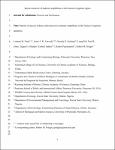Patterns of species richness and turnover in endemic amphibians of the Guineo-Congolian rainforest.
| dc.contributor.author | Nneji, LM | |
| dc.contributor.author | Azevedo, JAR | |
| dc.contributor.author | Oyebanji, OO | |
| dc.contributor.author | Ma, L | |
| dc.contributor.author | Elsen, PR | |
| dc.contributor.author | Salako, G | |
| dc.contributor.author | Puschendorf, Robert | |
| dc.contributor.author | Pringle, RM | |
| dc.date.accessioned | 2023-05-22T14:02:42Z | |
| dc.date.available | 2023-05-22T14:02:42Z | |
| dc.date.issued | 2023-06-09 | |
| dc.identifier.issn | 1366-9516 | |
| dc.identifier.issn | 1472-4642 | |
| dc.identifier.uri | https://pearl.plymouth.ac.uk/handle/10026.1/20911 | |
| dc.description.abstract |
Aim: The African Guineo-Congolian (GC) region is a global biodiversity hotspot with high species endemism, bioclimatic heterogeneity, complex landscape features, and multiple biogeographic barriers. Bioclimatic and geographic variables influence global patterns of species richness and endemism, but their relative importance varies across taxa and regions and is poorly understood for many faunas. Here, we test the hypoth-esis that turnover in endemic amphibians of the GC biodiversity hotspot is influenced mainly by the geographic distance between grid cells and secondarily by rainfall- and temperature- related variables.Location: West and Central Africa.Major Taxa Studied: Amphibians.Methods: We compiled species-occurrence records via field sampling, online data-bases, and taxonomic literature. Our study used 1205 unique georeferenced records of 222 amphibian species endemic to the GC region. Patterns of species richness were mapped onto a grid with a spatial resolution of 0.5° × 0.5°. We estimated weighted en-demism and tested whether endemism was higher than the expected species richness (randomization test). We quantified species turnover using generalized dissimilarity modelling to evaluate the processes underlying observed patterns of species rich-ness in GC endemic amphibians. We explored bioregionalization using agglomerative hierarchical clustering based on the unweighted pair group method with arithmetic averages.Results: We identified seven areas within the lower GC region – forests in Cameroon, Gabon, Southern Nigeria, Equatorial Guinea, Republic of Congo, Democratic Republic of Congo, and Cote d'Ivoire – as having high species richness of endemic amphib-ians. The randomization test returned four major areas of significant weighted end-emism: Nigeria-Cameroon mountains, forest regions of the Democratic Republic of Congo, Cote d'Ivoire, and Ghana. Our analysis revealed five bioregions for amphibian endemism, four of which were located within the lower Guineo-Congolian forest. Species turnover was strongly related to the geographic distance between grid cells; contributing bioclimatic variables included precipitation of the warmest quarter, mean temperature of the wettest quarter, and mean diurnal temperature range.Main Conclusions: Our results indicate that geographic distance between grid cells is the primary determinant of turnover in GC endemic amphibians, with secondary but significant effects of rainfall- and temperature-related variables. Our study identifies key areas of endemic amphibian richness that could be prioritized for conservation actions. | |
| dc.format.extent | 1035-1051 | |
| dc.language | en | |
| dc.publisher | Wiley Open Access | |
| dc.subject | Africa | |
| dc.subject | amphibians | |
| dc.subject | endemic species richness | |
| dc.subject | generalized dissimilarity modelling | |
| dc.subject | species distribution models | |
| dc.subject | beta-diversity | |
| dc.title | Patterns of species richness and turnover in endemic amphibians of the Guineo-Congolian rainforest. | |
| dc.type | journal-article | |
| dc.type | Journal Article | |
| plymouth.author-url | https://www.webofscience.com/api/gateway?GWVersion=2&SrcApp=PARTNER_APP&SrcAuth=LinksAMR&KeyUT=WOS:001007457300001&DestLinkType=FullRecord&DestApp=ALL_WOS&UsrCustomerID=11bb513d99f797142bcfeffcc58ea008 | |
| plymouth.issue | 8 | |
| plymouth.volume | 29 | |
| plymouth.publication-status | Published | |
| plymouth.journal | Diversity and Distributions | |
| dc.identifier.doi | 10.1111/ddi.13717 | |
| plymouth.organisational-group | |Plymouth | |
| plymouth.organisational-group | |Plymouth|Faculty of Science and Engineering | |
| plymouth.organisational-group | |Plymouth|Faculty of Science and Engineering|School of Biological and Marine Sciences | |
| plymouth.organisational-group | |Plymouth|REF 2021 Researchers by UoA | |
| plymouth.organisational-group | |Plymouth|Users by role | |
| plymouth.organisational-group | |Plymouth|Users by role|Academics | |
| plymouth.organisational-group | |Plymouth|REF 2021 Researchers by UoA|UoA06 Agriculture, Veterinary and Food Science | |
| dcterms.dateAccepted | 2023-05-11 | |
| dc.date.updated | 2023-05-22T14:02:42Z | |
| dc.rights.embargodate | 2023-7-5 | |
| dc.identifier.eissn | 1472-4642 | |
| dc.rights.embargoperiod | forever | |
| rioxxterms.versionofrecord | 10.1111/ddi.13717 |


